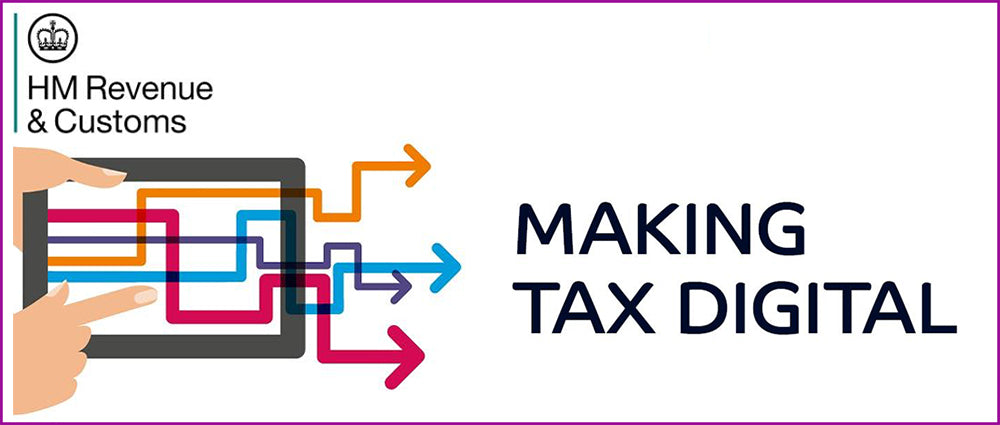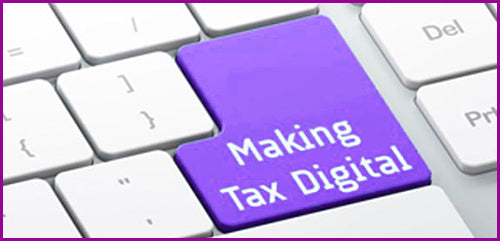MAKING TAX DIGITAL
UPDATE FEBRUARY 2019
The final countdown to Making Tax Digital (MTD)
As part of a wider UK Government initiative HMRC is gradually changing the relationship between the tax payer and the government by ensuring that most of its dealings with taxpayers in the future will be online .
From April this year, HMRC’s flagship initiative ‘Making Tax Digital’ (MTD) comes into effect. Initially the impact will be on UK VAT-registered businesses over the current £85,000 VAT threshold.
While MTD doesn't change the VAT schemes that businesses are on, it does have a significant impact on how records are kept, how data used for transactions is handled and how the process of filing with HMRC is managed.
For those businesses what are using spreadsheets, desktop software or bespoke systems, it is unlikely that these will be compliant unless additional software or upgrades are purchased and installed.
One of the major criticisms has been the lack of communication with the taxpayer. it has taken HMRC a while to communicate all of those affected; the first formal communication was via social media in late October last year with only six months before MTD would come into effect! The next communication what by letter a month later to some but certainly not all, leaving the possibility that many small businesses could be unaware or unprepared.
So, what do you do to make sure did you are Ready for the new digital age and are compliant?
Bookkeeping Technology is the key to success
Bookkeeping is the secret of financial management and of MTD for VAT. It’s not rocket science.Fraud is frequently quoted as the reason for the tax gap; but undoubtedly human error also plays a part. Part of the rationale behind MTD is the reduction and eventual elimination of human error by the introduction of digital record-keeping. Therefore, HMRC is attempting to minimise and eventually eliminate as much manual processing as possible.
Spreadsheets
In a recent concession HMRC accepted that Spreadsheets are an acceptable form of digital record keeping; but in order to be compliant they must use bridging software to complete the filing process. And that is the core of the issue. At the time of writing the bridging software is still not available, from all commercial software suppliers. This bridge is known as the ‘digital link’.
These solutions are primarily being marketed to accountants in practice to help them service is many clients as possible. There is concern, however, that there is a long-term issue with spreadsheets: As more taxes become digital in the future no one can be sure for how long they will be acceptable.
The Cost of the Digital Link
Digital links are a way of automatically processing data, such as filing totals for VAT returns, without rekeying or even copying and pasting. For example, at the moment data may need to be collected from several different sources in order to complete a VAT return. The problem arises when onewants to file the result. In other words, to create the ‘digital link’. Currently HMRC is taking a soft approach for businesses that rely on data from multiple sources to create the required ‘digital link’;but there is no soft landing for filing and thereby create the digital link. In the future, however, VAT inspections will include looking at the whole process to ensure a seamless digital link.
Ultimately there is a cost implication for accountants and for businesses alike. The best advice available now is to consult your accountant and seek his or her help when choosing software that will be acceptable not just in the short term; but also, into the foreseeable future. Clients’ software must be compatible with the accountants’ systems and software.
In conclusion, watch this space...
Mary Talbot-Rosevear

Making Tax Digital (MTD)
The thinking behind Making Tax Digital (MTD) is to make the UK tax system amongst one of the most efficient in the world.
Making Tax Digital (MTD) will be the most significant change to, and have the most impact on, businesses in decades. The introduction will be in two phases:
- 1st April 2019 will see the introduction of MTD for VAT
- 1st April 2020 will see the introduction for Income Tax and thereafter for Corporation Tax
First some background...
On 13 July 2017, the Government announced MTD would be introduced in April 2019 for businesses with turnover above the VAT threshold (currently £85,000) and would be delayed until at least 2020 for all other businesses.
Under the proposed timetable, only businesses with a turnover above the VAT threshold (currently £85,000) will have to keep digital records, and initially only for VAT purposes from 2019.
As VAT already requires quarterly returns, no business will need to provide information to HMRC more regularly during this initial phase than they do now.
HMRC started piloting MTD for VAT at the end of 2017. The small-scale private testing is now being followed by a wider, live pilot which started in Spring 2018. This wider pilot will be tested for over a year before any businesses are required to use the system.
Making Tax Digital (MTD) – The Vision
There are a number of reasons why MTD is being introduced for UK Tax Payers:
Better use of informationHer Majesty’s Revenue and Customs (HMRC) will use information from third parties such as employers, banks and other government departments, so that taxpayers do not have to provide information that HMRC has already. Taxpayers will be able to check that the information held about them is correct.
Tax in real time
HMRC will obtain and process information relating to tax as close as possible to real time so that it will not be necessary to wait until after the end of the tax year to know how much tax needs to be paid.
A Single Account
Now, most taxpayers haven’t an overview, in one place, of their liabilities and entitlements. By 2020, taxpayers will have that facility in a single, digital account.
Interacting digitally with taxpayers
Taxpayers and their agents will be able to interact digitally with HMRC at any time that suits them.
The key to all of this will be the requirement to keep digital records; and to use compatible software to submit returns to HMRC.
What it means for your business
The UK Government has confirmed that Making Tax Digital will start to be implemented in April 2019, initially for VAT registered businesses.
From this date, all your accounting and VAT records will need to be digital. That means no more manual books and records. You will need to make the move to digital accounting. Excel type spreadsheets may still be used but their output will need to meet HMRC prescribed standards and formats. Bespoke software such as Sage, Quickbooks and Sage Instant will need to be updated to HMRC requirements.
Many of our clients are already keeping digital accounting records. Our practice offers accounting and book-keeping services which are available to help you make the transition to Digital Accounting as straightforward as possible.
Making Tax Digital (MTD) for VAT
Just for those of you waiting with baited breath for the start date, MTD for VAT is still scheduled to start on the 1st April 2019, 84 days or 12 weeks. For those on the regular stagger, this is the last quarter on the existing reporting standard.
Apart from Agents having to create their own account with HMRC, we still await confirmation from all suppliers that the appropriate digital links to HMRC are approved in order to go live from 1st April.

